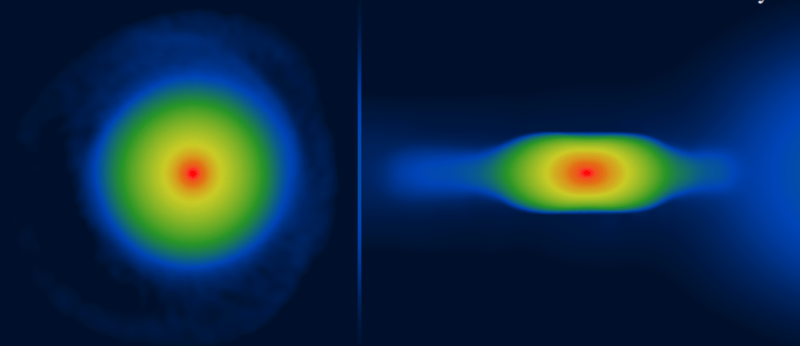
While the very idea of a flat planet millions of years after its formation is patently ridiculous, recent modelling shows that during the protostar phase – where material from a nebula is drawn around a hydrostatic core into an accretion disc – it is likely that many of of the protoplanets which form inside a fragmentary protostar accretion disc take on a strongly oblate spheroid shape, rather than a spherical one. This according to [Adam Fenton] and [Dimitris Stamatellos], who ran half a million CPU hours worth of simulation time at the UK’s DiRAC HPC facility, per the University of Central Lancashire (UCLan) press release.
The research was published in the February 2024 issue of Astronomy & Astrophysics, titled The 3D structure of disc-instability protoplanets.
Where this research is essential is not just in our understanding of how our own solar system came to be – including our own oblate spheroid Earth – but also in interpreting what we observe via the Hubble Space Telescope, James Webb Space Telescope and others as we examine areas of the observable Universe such as the Orion Nebula, which is one of the regions with the most actively forming stars. By comparing these simulations with observations, we may find that the simulation matches perfectly, matches partially, or perhaps not at all, which provides data to refine the simulation, but also helps to reconsider how observations were previously interpreted.
















In before someone claims this is proof Earth is flat! /s
My sentiments exactly!
so there’s a chance!!!
Cool,
maybe they’ll find some hollow ones too…
…Until the hydrodynamic motions of gravitating fluids form a geodesic matrix, i.e. an oblate sphere.
What if it’s spinning really fast, I wonder if there are any solid planets out there with absurdly short rotational periods.
You could rotate up to orbital escape velocity – after that you start flinging parts off into space (making some assumptions about structural strength).
Some point before that though the object would be less a planet and more a collection of rocks.
Is it really a planet if it’s just a loose cloud of fast spinning gravel and dust?
Maybe it’s a planet experiencing a really big sandstorm.
No but we’re talking about protoplanets which are technically different things. However, I think the “gravel” is more likely chunks of heavier (than the gas around it) elements. I’m not an astrophysicist, so don’t quote me on that.
It’s probably pretty well crushed up from all the collisions, and hot, so it’s more like a slurry of lava and gases at least for the central parts.
Is a gas giant really a planet?
Or a failed star?
Planets need to be in “hydrostatic equilibrium”, which means a pile of gravel flung into a disc by centrifugal forces isn’t yet a planet.
Mass is mass?
It’s the Discworld! https://en.wikipedia.org/wiki/Discworld
Need one elephant and fore Turtles !
Sigh. We all know where this is going.
Some joke about the 1990 Public Enemy album but “Fear of a Flat Planet?” I’m still working on it but I know that there’s something in there
Well I’m looking forward to my vacation on Pancake 5.
I knew it. The earth is flat after all. It’s just wrapped around a large ping pong ball filled with magma.
I do hope that if they find one they name it “Pratchett”.
God no, please no! Don’t let them flat earthers learn this! It’s stupid already without this being real, don’t want to even imagine if they learn about this!
In the infamous words of Montgomery Scott, “How do we know they didn’t come up with the thing?”